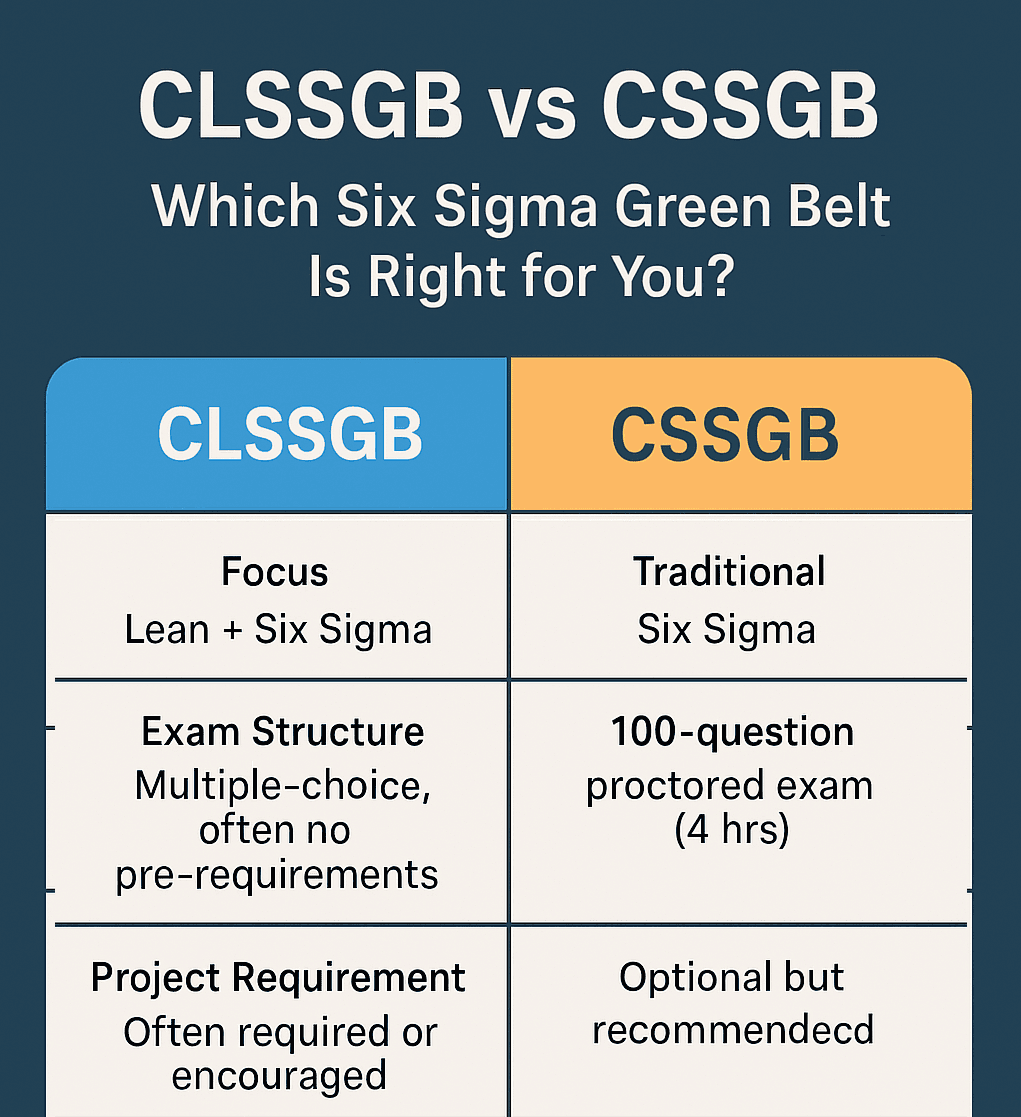
CLSSGB vs CSSGB—if you're considering a Six Sigma Green Belt certification, this is a decision you must make early. With several certifying bodies offering Lean Six Sigma credentials, it can be confusing to understand the key differences between the Certified Lean Six Sigma Green Belt (CLSSGB) and the Certified Six Sigma Green Belt (CSSGB) from the American Society for Quality (ASQ).
Both certifications validate your skills in process improvement, quality management, and data-driven decision-making. But which one is right for you? Let’s break it down.
The Role of Artificial Intelligence in Personalized Education
What Is CLSSGB?
CLSSGB stands for Certified Lean Six Sigma Green Belt, commonly issued by institutes that combine traditional Six Sigma with Lean principles. Providers may include IASSC (International Association for Six Sigma Certification), TUV, BSI, or independent training organisations.
The CLSSGB certification typically covers:
- Lean principles (waste reduction, value stream mapping)
- DMAIC methodology (Define, Measure, Analyse, Improve, Control)
- Statistical tools and process capability
- Root cause analysis
- Kaizen, 5S, and other lean frameworks
The CLSSGB is ideal for professionals who want a broader understanding of both Lean and Six Sigma methodologies and often includes project-based learning.
What Is CSSGB?
CSSGB is the Certified Six Sigma Green Belt issued by the American Society for Quality (ASQ)—one of the most globally recognised quality associations.
The CSSGB certification focuses more rigorously on:
- DMAIC phases with deeper statistical depth
- Hypothesis testing, regression analysis, and design of experiments
- Quality improvement through Six Sigma tools
- Project leadership under the guidance of a Black Belt
ASQ’s CSSGB is exam-based and widely respected in regulated industries like manufacturing, healthcare, and pharmaceuticals. It is perfect for professionals seeking a globally benchmarked certification with a strong emphasis on quantitative analysis.
CLSSGB vs CSSGB: Key Differences at a Glance
| Feature | CLSSGB | CSSGB (ASQ) |
|---|---|---|
| Certifying Body | Multiple (IASSC, TUV, etc.) | American Society for Quality (ASQ) |
| Focus | Lean + Six Sigma | Traditional Six Sigma (more statistical) |
| Exam Structure | Multiple-choice, often no pre-requirements | 100-question proctored exam (4 hrs) |
| Project Requirement | Often required or encouraged | Optional but recommended |
| Recognition | Depends on the issuing body | Global, highly recognised |
| Ideal For | Operations, logistics, services | Manufacturing, healthcare, engineering |
| Cost | Varies ($200–$600) | ~$438 (member price), ~$538 (non-member) |
Which One Should You Choose?
When comparing CLSSGB vs CSSGB, the choice often comes down to your career goals, industry, and desired depth of knowledge.
- Choose CLSSGB if you work in service industries, startups, or operations-focused roles where speed and lean practices are key.
- Choose CSSGB if you work in regulated or technical sectors where statistical rigour, global recognition, and standardised methodologies matter.
Real-World Examples
Case 1: Operations Manager in Retail
Priya works in a fast-paced retail chain where reducing waste and optimising workflow is essential. She chooses the CLSSGB certification because it gives her lean tools like 5S and value stream mapping, immediately applicable to her role.
Case 2: Quality Analyst in Manufacturing
John is a quality analyst at a medical device manufacturer. His employer prefers ASQ-recognised credentials. He opts for the CSSGB, knowing it will demonstrate his ability to handle in-depth quality metrics and meet regulatory expectations.
Benefits of Each Certification
Benefits of CLSSGB:
- Broader lean thinking skills
- Quick deployment in dynamic sectors
- Practical, project-based applications
- Flexibility in training formats
Benefits of CSSGB:
- Global recognition by employers
- Trusted credential in engineering and manufacturing
- Stronger statistical analysis foundation
- Comprehensive understanding of Six Sigma
Final Verdict: CLSSGB vs CSSGB
There’s no one-size-fits-all answer in the CLSSGB vs CSSGB debate. If your priority is rapid improvement, lean methodology, and flexible training options, CLSSGB could be your go-to. But if your role requires statistical depth and recognised credentials—especially in technical or regulated sectors—CSSGB by ASQ may be the smarter investment.
Before deciding, consider your target industry, geographic recognition needs, and the depth of content you're ready to master. Whichever you choose, both certifications open the door to better process improvement, career growth, and strategic impact.
We have all levels of Lean Six Sigma offered including White and Yellow Belt as free whereas Green, Black, and Master Black Belt is also available.
Visit The Case HQ for 95+ courses
Read More:
The Rise of Intelligent Tutoring Systems: A New Era in Education
AI and the Future of Assessment: From Standardized Tests to Adaptive Learning
AI in Early Childhood Education: Promises and Pitfalls
How AI is Shaping the Role of Educators in the 21st Century
AI and Special Education: Customizing Learning for Every Student
Critical Analysis: How Students Use Gen AI for Essay Writing—Should We Be Concerned?
Essential Comparison of CLSSGB vs CSSGB: Which Six Sigma Green Belt Is Right for You?
Powerful Guide to Writing Exam Questions Using Gen AI Effectively
Time-Saving Power of Using ChatGPT to Generate Lesson Plans in Minutes
Essential Guide: What Is Generative AI and Why Should Educators Care?
Innovative Ways Art & Design Schools Use AI for Portfolio Assessments
Transformative Power of AI for Assessment Dashboards and Performance Reports
Top-Rated AI Assessment Tools for Schools and Universities in 2025
https://thecasehq.com/essential-comparison-of-clssgb-vs-cssgb-which-six-sigma-green-belt-is-right-for-you/?fsp_sid=2097
Comments
Post a Comment